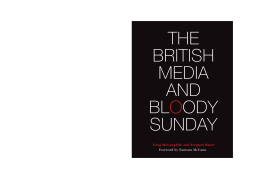
Additional Information
Book Details
Abstract
On Bloody Sunday, January 30, 1972, British paratroopers killed thirteen innocent men in Derry. It was one of the most controversial events in the history of the Northern Ireland conflict and also one of the most mediated. The horror was recorded in newspapers and photographs, on TV news and current affairs, and in film and TV drama. In a cross media analysis that spans a period of almost forty years up to the publication of the Saville Report in 2010, The British Media and Bloody Sunday identifies two countervailing impulses in media coverage of Bloody Sunday and its legacy: an urge in the press to rescue the image and reputation of the British Army versus a troubled conscience in TV current affairs and drama about what was done in Britain’s name. In so doing, it suggests a much more complex set of representations than a straightforward propaganda analysis might allow for – one that says less about the conflict in Ireland than it does about Britain, with its loss of empire and its crisis of national identity.
Table of Contents
| Section Title | Page | Action | Price |
|---|---|---|---|
| Cover | FC | ||
| Half-title | i | ||
| Title | iii | ||
| Copyright | iv | ||
| Dedication | v | ||
| Contents | vii | ||
| Acknowledgements | ix | ||
| Foreword | 1 | ||
| Chapter 1: The British Media and Bloody Sunday: An introduction | 7 | ||
| Methods of analysis | 11 | ||
| Bloody Sunday in context | 13 | ||
| Ideology and the British national myth | 16 | ||
| Too close for comfort: The press in Belfast, Derry and Dublin | 18 | ||
| Outline | 23 | ||
| Notes | 24 | ||
| Chapter 2: The British press, Bloody Sunday and the Widgery Report | 27 | ||
| Part One: Reporting Bloody Sunday | 30 | ||
| The ‘battle’ | 31 | ||
| The ‘massacre’ | 33 | ||
| The soldiers | 35 | ||
| Ulstermen, Irishmen and the Wildcat girl | 36 | ||
| Part Two: Reporting Widgery | 40 | ||
| The advance briefing | 41 | ||
| Resolving the contradictions | 44 | ||
| Concluding remarks | 48 | ||
| Notes | 48 | ||
| Chapter 3: The British press and the Saville Report | 51 | ||
| The guilty innocent | 56 | ||
| The innocent guilty | 58 | ||
| The verdict on Saville | 64 | ||
| To prosecute or not to prosecute | 68 | ||
| Implications for the peace process? | 70 | ||
| After Saville: The murder inquiry | 72 | ||
| Concluding remarks | 74 | ||
| Notes | 75 | ||
| Chapter 4: Inside stories and secret histories: British television investigates Bloody Sunday | 77 | ||
| British television and the conflict in Northern Ireland | 80 | ||
| Analysis | 83 | ||
| Setting the scene | 83 | ||
| Providing context | 86 | ||
| Visualizing the shootings | 87 | ||
| What really happened? Evidence and eyewitness testimony | 91 | ||
| Closing the scene | 102 | ||
| Channel 4 News investigates | 107 | ||
| Concluding remarks | 110 | ||
| Notes | 112 | ||
| Chapter 5: Sunday and Bloody Sunday: Very British tragedies? | 115 | ||
| Formations | 118 | ||
| Bloody Sunday: A fatal collision | 122 | ||
| Sunday: Conflicting genres | 128 | ||
| Contexts: British and Irish | 136 | ||
| Concluding remarks | 140 | ||
| Notes | 141 | ||
| Chapter 6: The British Media and Bloody Sunday: Lest they forget | 143 | ||
| Notes | 153 | ||
| Bibliography | 155 | ||
| Index | 163 | ||
| BackCover | BC |
